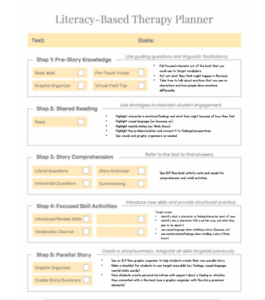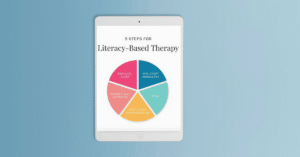This is a guest blog post by Monica, a school-based SLP, all about tips for implementing literacy-based therapy with autistic students.
I’m using “autistic” instead of “students with autism” because that’s the preferred term when using a neurodiversity-affirming approach. Research articles will be reviewed in this post, but keep in mind that each study has a limited population used, and it may not match the population of your caseload. I see the research as a great starting point to direct what we do in our sessions. It’s just as important to use clinical judgment (with information from the autistic community) and consider what your students and their families want to work on.
Why literacy-based therapy?
Literacy-based therapy is a great way to include perspective-taking and inferencing goals in an academically relevant context.
Research has shown that working on narratives with autistic students has been correlated with improvements in perspective taking, verbal memory performance, overall story complexity, and story grammar knowledge (Gilliam et al., 2015).
Some research has shown that narratives are an area of difficulty that could carry into adulthood (Hewitt, 2019).
Improvements in narrative abilities with literature have also been linked to improvements with personal narratives (Petersen et al., 2014).
How do I know what goals to target?
Including narratives as part of your testing is the easiest way to know what to target.
You can use the CUBED: Narrative Language Measures (Petersen & Spencer, 2016) as a formal or informal measure of narrative language skills. It’s FREE and covers listening retell, story grammar, language complexity, story comprehension, vocabulary, and personal generation.
If you’re interested in a dynamic version, the DYMOND (Petersen & Spencer, 2017) is currently in development. You’ll get a wealth of information from this test (and a great language sample from the personal generation).
Here are some examples of areas you could target (not a complete list):
📚 Retell a story using X number of story grammar elements (emphasizing the story grammar elements students were not able to produce during testing).
📚 Identify story grammar elements in a story (e.g., problem and solution).
📚 Identify what a character is feeling and/or a character’s point of view.
📚 Identify why a character felt a certain way and what they plan to do about it.
📚 Use causal language when retelling a story (because, so).
📚 Use mental states/feelings when retelling a story (think, know).
📚 Answer comprehension questions.
📚 Generate a personal narrative using X number of story grammar elements.
How do I set my students up for success?
Here are some quick ways to modify literacy-based therapy!
When we’re using a neurodiversity-affirming approach, we’re looking at how we can modify the environment and add supports rather than requiring the student to change.
Environmental Supports
✏️ Do a check-in with students before and during your lesson to make sure their sensory and emotional systems are regulated.
✏️ Add support for regulation by going over the plan. (I put everything on the table we will be using in the order we’re doing it and give time estimates for each task.)
✏️ Add sensory breaks between tasks.
✏️ Have a backup lesson for days when sustained tabletop activities are not doable. (You can focus on expanding vocabulary and acting out scenes from the book if you need to get up and move or do something more interactive.)
Internal Motivation
📖 Have clear expectations and a routine for your lessons.
📖 Introduce what you’re going to do, incorporate breaks, give time estimates, set up clear transitions, and provide visuals as needed.
📖 Choose books that students are interested in. (I will switch to a focused interest for a book instead of picking a themed book if it will help with engagement.)
📖 Explain why you’re working on that task. (I ask students what’s hard for them at school/when talking to friends and connect it to what we’re working on in speech.)
📖 Use play-based activities leading up to the book during pre-story activation to build excitement and interest for the book.
Executive Functioning
🖍 Help students’ working memory by providing visuals (Gilliam et al., 2015).
🖍 Use graphic organizers (Gilliam et al., 2015).
🖍 Modify the pace and content of your lessons (Gilliam et al., 2015). (You may have to spend more time teaching story grammar elements before going into retells with all of the elements or reduce the amount of story grammar elements you teach.)
What should my sessions look like?
You can run your lessons like the typical literacy-based sessions with some modifications to increase engagement and dedicate more time to certain targets (like perspective-taking).
I tend to teach story grammar elements before using the full literacy-based therapy framework based on my students’ needs.
I reviewed two articles (Gilliam et al., 2015 and Petersen et al., 2014) about using narrative language interventions for autistic students. Both studies taught story grammar elements first before moving on to the other parts of the intervention. The study by Gilliam et al., 2015) had three phases.
The first phase taught story grammar elements, the second phase covered “connecting and elaborating phrases,” and the third phase focused on “creating and editing stories.”
In the second phase, the following was covered: causal language (e.g., because, so), mental state and linguistic verbs (know, laughed), adverbs (if/then), and elaborated noun phrases (two green frogs). The researchers suggested that adverbs and elaborated noun phrases should not be included for students who need more support to reduce the overall cognitive load during sessions. In this study, they added two story grammar icons for support (dialogue and plan again).
Both studies highlighted the use of supports and scaffolding to reduce those supports.
Here’s an example of modifications you could make using the SLP Now literacy-based therapy planner. Here’s a link if you need it!

How do I explain it to parents?
In meetings, my district goes over strengths and challenges as a team, so it’s easy to bring up narrative therapy as a tool to cover a wide range of challenges.
I talk about how narratives target verbal working memory, perspective-taking/inferencing skills, and are relevant to what students will be working on in the classroom. Because narratives are so interwoven in our daily lives, I also talk about how there is evidence that working on narratives with literacy can generalize to improved personal narratives (Petersen et al., 2014).
Working on story grammar elements gives students a mental checklist and structure (schema) of what a story should have, which makes it a lot easier to tell a story independently. Microstructure is also targeted with narratives, so we’re able to target a lot of goals with literacy-based therapy!
I hope these tips were helpful! SLP Now members can always reach out for help through our membership site if they have questions about implementing literacy-based therapy with their students.
References
Gillam, S. L., Hartzheim, D., Studenka, B., Simonsmeier, V., & Gillam, R. (2015). Narrative Intervention for Children With Autism Spectrum Disorder (ASD). Journal of Speech, Language, and Hearing Research, 58(3), 920–933.
Hewitt, L. E. (2019). Narrative as a Critical Context for Advanced Language Development in Autism Spectrum Disorder. Perspectives of the ASHA Special Interest Groups, 4(3), 430–437.
Petersen, D. B., Brown, C. L., Ukrainetz, T. A., Wise, C., Spencer, T. D., & Zebre, J. (2014). Systematic Individualized Narrative Language Intervention on the Personal Narratives of Children With Autism. Language, Speech, and Hearing Services in Schools, 45(1), 67–86.







Leave a Reply